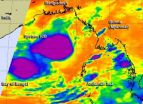(Press-News.org) May 25, 2014 — (Bronx, NY) — Researchers at Albert Einstein College of Medicine of Yeshiva University have discovered a signaling pathway in cancer cells that controls their ability to invade nearby tissues in a finely orchestrated manner. The findings offer insights into the early molecular events involved in metastasis, the deadly spread of cancer cells from primary tumor to other parts of the body. The study was published today in the online edition of Nature Cell Biology.
To migrate from a primary tumor, a cancer cell must first break through surrounding connective tissue known as the extracellular matrix (ECM). The cancer cell does so by forming short-lived invadopodia––foot-like protrusions these cells use to invade. Invadopodia release enzymes that degrade the ECM, while other protrusions pull the cancer cell along, much like a locomotive pulls a train. The invading cancer cell relies on the cycle of invadopodium formation/disappearance to successfully travel from the tumor and enter nearby blood vessels to be carried to distant parts of the body.
"We've known for some time that invadopodia are driven by protein filaments called actin," said study leader Louis Hodgson, Ph.D., assistant professor of anatomy and structural biology at Einstein. "But exactly what was regulating the actin in invadopodia was not clear."
Previous studies had suggested that a protein called Rac1 played a role in cancer-cell invasion. When Rac1 levels are elevated, cancer cells display more invasive characteristics. But this suspected Rac1 activity in invadopodia had never been directly observed, only indirectly inferred.
To surmount this hurdle, Dr. Hodgson and his colleagues in the Gruss Lipper Biophotonics Center at Einstein devised a new fluorescent protein biosensor that, combined with live-cell imaging, revealed exactly when and where Rac1 is activated inside cancer cells.
Using this biosensor in highly invasive breast cancer cells taken from rodents and humans, the Einstein team discovered that when an individual invadopodium forms and is actively degrading the ECM, its Rac1 levels are low; on the other hand, elevated Rac1 levels coincide with the invadopodium's disappearance. "So high levels of Rac1 induce the disappearance of ECM-degrading invadopodia, while low levels allow them to stay—which is the complete opposite of what Rac1 was thought to be doing in invadopodia," said Dr. Hodgson.
To confirm this observation, the researchers used siRNAs (molecules that silence gene expression) to turn off the RAC1 gene, which synthesizes Rac1 protein. When the gene was silenced, ECM degradation increased. Conversely, when Rac1 activity was enhanced—using light to activate a form of the Rac1 protein—the invadopodia disappeared.
In subsequent experiments, the Einstein team deciphered other parts of the Rac1 signaling cascade during invasion and showed that this signaling mechanism is regulated differently in normal breast epithelial cells.
"Rac1 levels in invadopodia of invasive tumor cells appear to surge and ebb at precisely timed intervals in order to maximize the cells' invasive capabilities," said Dr. Hodgson.
Most of the 580,000 U.S. cancer deaths each year are caused by complications from the spread of cancer to distant tissues and organs, rather than from the primary tumor itself. So throwing a monkey wrench into the inner workings of invasive tumor cells—perhaps with a drug that prevents them from locally activating or inhibiting Rac1—could be extremely useful.
"Rac1 inhibitors have been developed," Dr. Hodgson said, "but it wouldn't be safe to use them indiscriminately. Rac1 is an important molecule in healthy cells, including immune cells. So we'd need to find a way to shut off this signaling pathway specifically in cancer cells."
INFORMATION:
The paper is titled "A Trio-Rac1-PAK1 signaling axis driving invadopodia disassembly." The other contributors are: John Condeelis, Ph.D., Jose Javier Bravo-Cordero, Ph.D., and Ph.D. students Yasmin Moshfegh and Veronika Miskolci, all at Einstein.
The study was supported by grants from the National Institutes of Health (GM093121, T32GM007491, and CA150344).
The authors report no conflicts of interest.
About Albert Einstein College of Medicine of Yeshiva University
Albert Einstein College of Medicine of Yeshiva University is one of the nation's premier centers for research, medical education and clinical investigation. During the 2013-2014 academic year, Einstein is home to 734 M.D. students, 236 Ph.D. students, 106 students in the combined M.D./Ph.D. program, and 353 postdoctoral research fellows. The College of Medicine has more than 2,000 full-time faculty members located on the main campus and at its clinical affiliates. In 2013, Einstein received more than $155 million in awards from the NIH. This includes the funding of major research centers at Einstein in diabetes, cancer, liver disease, and AIDS. Other areas where the College of Medicine is concentrating its efforts include developmental brain research, neuroscience, cardiac disease, and initiatives to reduce and eliminate ethnic and racial health disparities. Its partnership with Montefiore Medical Center, the University Hospital and academic medical center for Einstein, advances clinical and translational research to accelerate the pace at which new discoveries become the treatments and therapies that benefit patients. Through its extensive affiliation network involving Montefiore, Jacobi Medical Center -Einstein's founding hospital, and five other hospital systems in the Bronx, Manhattan, Long Island and Brooklyn, Einstein runs one of the largest residency and fellowship training programs in the medical and dental professions in the United States. For more information, please visit www.einstein.yu.edu, read our blog, follow us on Twitter, like us on Facebook, and view us on YouTube. END
Study identifies how signals trigger cancer cells to spread
2014-05-25
ELSE PRESS RELEASES FROM THIS DATE:
Scientists discover potential new target for cancer immunotherapy
2014-05-25
HOUSTON -- Scientists have found a way to target elusive cells that suppress immune response, depleting them with peptides that spare other important cells and shrink tumors in preclinical experiments, according to a paper published online by Nature Medicine.
"We've known about these cells blocking immune response for a decade, but haven't been able to shut them down for lack of an identified target," said the paper's senior author, Larry Kwak, M.D., Ph.D., chair of Lymphoma/Myeloma and director of the Center for Cancer Immunology Research at The University of Texas MD ...
Researchers map the epic evolution of a 'ring species'
2014-05-25
The Greenish Warbler, long considered an idealized example of a single species that diverged into two as it expanded its range, has a much more checkered family history than biologists previously realized.
Ring species are a continuous loop of related populations, each adapted to its local environment, with two terminal populations in the loop meeting but now unable to mate. But an in-depth genomic analysis published today in Nature by University of British Columbia researchers reveals that the Greenish Warbler's genetic migration through central Asia involved periods ...
Advanced light
2014-05-25
Michael Lewis's bestselling book "Flash Boys" describes how some brokers, engaging in high frequency trading, exploit fast telecommunications to gain fraction-of-a-second advantage in the buying and selling of stocks. But you don't need to have billions of dollars riding on this-second securities transactions to appreciate the importance of fast signal processing. From internet to video streaming, we want things fast.
Paul Lett and his colleagues at the Joint Quantum Institute (1) specialize in producing modulated beams of light for encoding information. They haven't ...
Sound and vision: Visual cortex processes auditory information too
2014-05-25
Scientists studying brain process involved in sight have found the visual cortex also uses information gleaned from the ears as well as the eyes when viewing the world.
They suggest this auditory input enables the visual system to predict incoming information and could confer a survival advantage.
Professor Lars Muckli, of the Institute of Neuroscience and Psychology at the University of Glasgow, who led the research, said: "Sounds create visual imagery, mental images, and automatic projections.
"So, for example, if you are in a street and you hear the sound of an ...
Brain imaging reveals clues about chronic fatigue syndrome
2014-05-24
A brain imaging study shows that patients with chronic fatigue syndrome may have reduced responses, compared with healthy controls, in a region of the brain connected with fatigue. The findings suggest that chronic fatigue syndrome is associated with changes in the brain involving brain circuits that regulate motor activity and motivation.
Compared with healthy controls, patients with chronic fatigue syndrome had less activation of the basal ganglia, as measured by fMRI (functional magnetic resonance imaging). This reduction of basal ganglia activity was also linked with ...
Slowing the insect invasion: Wood packaging sanitation yields US $11.7 billion net benefit
2014-05-24
The emerald ash borer (Agrilus plantipenis), a recent insect immigrant to North America carried in with the wooden packing material of imported goods, is projected to cause over a billion dollars in damages annually over the next decade. International standards now require expensive fumigation or heat treatment of wood pallets and crates to prevent the inadvertent import of new wood boring insect pests in shipping materials.
Preventative treatment is worthwhile when the cumulative damages of widening infestations are considered, report scientists in Ecological Society ...
Untangling whole genomes of individual species from a microbial mix
2014-05-23
BETHESDA, MD – May 23, 2014 – A new approach to studying microbes in the wild will allow scientists to sequence the genomes of individual species from complex mixtures. It marks a big advance for understanding the enormous diversity of microbial communities —including the human microbiome. The work is described in an article published May 22 in Early Online form in the journal G3: Genes|Genomes|Genetics, published by the Genetics Society of America.
"This new method will allow us to discover many currently unknown microbial species that can't be grown in the lab, while ...
Dawn breaks on Tropical Storm Amanda in Eastern Pacific
2014-05-23
Shortly after dawn broke in the Eastern Pacific Ocean this morning, May 23, Tropical Depression 1E organized and strengthened into the first tropical storm of the season: Amanda
NOAA's GOES-West satellite provided a visible image of Amanda on May 23 at 1500 UTC (11 a.m. EDT/8 a.m. PDT). The GOES imagery showed strong thunderstorms in the northern and western quadrants and is indicative of a better structure in the banding of thunderstorms around the low-level center of circulation.
By that time, Amanda's maximum sustained winds had increased to 40 mph (65 kph). Tropical-storm-force ...
Poor diet before pregnancy is linked with preterm birth
2014-05-23
University of Adelaide research has for the first time confirmed that women who eat a poor diet before they become pregnant are around 50% more likely to have a preterm birth than those on a healthy diet.
Researchers at the University of Adelaide's Robinson Research Institute investigated the dietary patterns of more than 300 South Australian women to better understand their eating habits before pregnancy.
It's the first study of its kind to assess women's diet prior to conception and its association with outcomes at birth.
The results, published in The Journal of ...
An infrared NASA eye sees a weaker System 92B
2014-05-23
System 92B appears to have weakened in the last day as an infrared look at the tropical low pressure area's cloud temperatures have shown. NASA's AIRS instrument is an infrared "eye in the sky" that recently flew over the weaker tropical low pressure area.
On May 22 at 19:29 UTC/3:29 p.m. EDT, NASA's Aqua satellite passed over System 92B and infrared data from the Atmospheric Infrared Sounder (AIRS) instrument and the SSMIS instrument saw patchy deep convection flaring and dissipating over the western portion of a low-level circulation center. Earlier on May 22, the areas ...





